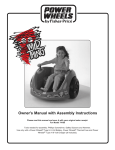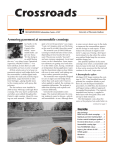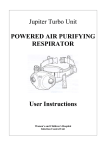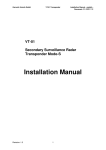Download Vol 28 No 3.indd
Transcript
INDIANA A Federal Highway Administration LTAP Technology Transfer Newsletter Vol. 28 No. 3 WHAT’S AHEAD IN THIS ISSUE 2 LTAP Training Calendar 5-6 LTAP Research in Progress: Retroreflectivity Study 7 ADA Information Corner 8-9 Highway Workers: Save Yourself 10 Planning to Save Lives 11-13 Focus on Local History: Covered Bridges in Indiana 14-16 The Power of Spreading It Around 16-17 LTAP Research Summaries 18 The Four E’s of Safety 18 Local and Rural Roads Safety Peer-to-Peer Program 20-21 Playing It Safe 23 Association Events Please route to your staff: Summer 2010 SAFETY in Indiana by Sarah Hubbard, P.E., Indiana LTAP Project Manager Reducing highway fatalities is a shared goal for agencies at all levels. While traffic fatalities are a leading cause of death for many age groups, the trends are positive. Recent statistics indicate that Indiana has continued to make significant progress in reducing the number of fatalities, with preliminary statistics indicating 680 deaths in 2009 on Indiana roadways, a 16 percent reduction from the 814 deaths for the same period in 2008, and the lowest level recorded since 1925.1 Nationally, traffic fatalities have also declined, with 33,963 deaths in 2009, an 8.9 percent reduction from the 37,261 deaths in 2008.2 The impact of safety extends beyond lost lives. In Indiana in 2008, there were over 205,000 crashes that resulted in injury or property damage, and the economic cost of all crashes was over $4.6 billion.3 Given the high cost of crashes, there has been a significant investment in programs to improve safety. In Indiana in 2008, $8.5 million in grants was provided to local law enforcement agencies for increased enforcement, and over $14 million in funding was dedicated to safety initiatives including research, media and program management.2 Closer to home, LTAP, with the support of INDOT and FHWA, has re-introduced the Hazard Elimination Project for Local Roads and Streets, perhaps better known as the HELPERS program. The HELPERS Program Local roads play an important role in maintaining mobility in Indiana, and increasing safety on local roads is an important goal. Recent analysis suggests that the injury crash rate on local roads in Indiana is more than twice the injury crash rate on state roads in Indiana, and more than 45 percent of Indiana’s highway fatalities occur on local roads. The primary objective of the HELPERS program is to work with local agencies to increase safety on local roads. HELPERS Activities. The HELPERS program includes a number of activities to assist local agencies increase safety on local roads. • Safety Training: Safety training provides an opportunity to share information about safety improvements, as well as a forum for local agencies to learn from one another. The HELPERS program held three safety training sessions throughout the state in December 2009, and a safety workshop is scheduled for July 2010. • Site Visits: If a local agency has a high crash location, the HELPERS engineer will visit the site and provide a preliminary evaluation of potential safety improvements. In some cases, low cost improvements that do not continued on page 3 Training Calendar Indiana LTAP Roadway Safety Workshop Indiana Local Technical Assistance Program (LTAP) was established by the Federal Highway Administration (FHWA). The purpose of the LTAP program is to translate the latest, state-of-the-art road, highway and bridge technologies into systems usable by local highway agencies. LTAP is funded by FHWA, the local agency distrubtion of the Motor Vehicle Highway Account and Purdue University. A newsletter is published quarterly by the Indiana LTAP office at Purdue University. It is distributed free to county, city or town road and street personnel, and others with tranportation responsibilites. July 29 West Lafayette Road Scholar Core Course #3 Road and Highway Funding August 25 at the ISCA Conference Plymouth Advisory Board Chairman Randy Strasser Vice Chair Stephanie Yager Transportation Expo & Snow Plow Roadeo County Commissioners Iris Kiesling, Monroe County Tom Murtaugh, Tippecanoe County Tom Stevens, Hancock County Walter Wilson, Fountain County Kevin Woodward, Wells County September 22-23 Mayors & Town Managers Bartholomew County Fairgrounds Columbus Gary Eakin, Town Manager, Town of Danville Michael Fincher, Mayor, City of Logansport Tom Jones, Mayor, City of Linton Randy Strasse, Mayor, City of Delphi LPA Federal Aid Certification Training Purdue University, Faculty Representatives Dr. Kathy Banks, Professor and Head of Civil Engineering Dr. Kumares Sinha, Professor Dr. Robert Connor, Professor Dr. Jon Fricker, Professor Dr. Jason Weiss, Professor FHWA Representatives October 7 Fort Wayne Portland Cement Concrete Pavement Workshop Dan Keefer, LPA and Asset Managment Coordinator INDOT Representatives November 18 Audra Blasdel, Grant Director, Local Programs Eric Conklin, Manager, Office of Technical Services Association Representatives Indiana Association of County Commissioners West Lafayette Stephanie Yager, Executive Director Indiana Association of County Highway Engineers and Supervisors Tom Kouns, Boone County Highway Supervisor Bill Williams, Monroe County Highway Director LPA Federal Aid Certification Training November 30 Indiana Street Commissioners Association Indianapolis Rob Roberts, Town of Danville Street Superintendent Indiana Association of City Engineers Adrian Reid, City of Bloomington Engineer Ex. Officio Members of the Board Phil Beer, USI Consultants, representing ACEC - Indiana Mike Bowman, Milestone Contractors, representing ICA Chuck Muller, Indiana 811, utilities representative John Thomas, Area Plan Commission of Tippecanoe County, representing MPO Council Anne Trobaugh, Indiana Association of Cities and Towns Bill Williams, Monroe County Highway Director, NACE States Representative Joe Williams, Brown Equipment, vendors representative Advisory Board Meetings The next meeting of the LTAP Advisory Board will take place on: Thursday, July 22, 2010 2 Road Scholar Core Course #4 Public Purchasing December 1 Indianapolis for more details on these workshops visit www.purdue.edu/INLTAP require outside funding are most appropriate; these improvements will be documented in a preliminary report for the local agency. Example improvements that may be implemented by the agency include recommendations for specific signing or marking in compliance with the Manual on Uniform Traffic Control Devices (MUTCD), and removal of vegetation to increase visibility. • Road Safety Assessments (RSA): In some cases, the results of the site visit and the crash history will indicate that a full scale road safety assessment (RSA) is appropriate. A road safety assessment is a formal safety performance examination of a road or intersection with an independent team. In addition to visiting the site, the RSA team considers all available information, including maps, crash data and crash diagrams and traffic volumes. The RSA results in a formal report that suggests both short-term and long-term countermeasures to improve safety. The report is given to the local agency, who can identify which of the suggested countermeasures are appropriate given their objectives and budget. • Clearinghouse for HSIP Funding for Class III and IV agencies: In some cases, proposed safety improvement projects may be eligible for federal aid money for construction of the recommended countermeasures. If the RSA identifies improvements that are eligible for funding through the Highway Safety Improvement Program (HSIP) and if the benefit cost ratio for the proposed project is high enough to warrant consideration, then the HELPERS office will assist the local agency in the submittal process for an application for funding for safety improvements. Overview. At the request of a local agency, the HELPERS program will help identify appropriate alternatives to Figure 1. The MUTCD provides guidelines for sign address a high crash location. The HELPERS office will placement (excerpt from MUTCD Figure 2A-2) coordinate an RSA to identify potential countermeasures that can be implemented to improve safety. In some cases, proposed projects may be eligible for federal aid money for construction of the recommended countermeasures. In other cases, the RSA will provide the local agency with a list of low-cost countermeasures that may be implemented with local forces as funding and time permit. Projects. The HELPERS program can help agencies with a variety of projects. Some of the projects funded under the first phase of the HELPERS program are described below. • Modify Intersection Traffic Control. Numerous crashes occurred at the intersection of Cartersburg Road and CR 200 South, prompting Hendricks County to request assistance of the HELPERS program. Based on a review of the existing conditions and the guidelines in the Manual on Uniform Traffic Control Devices, a number of safety improvements were suggested. The suggested improvements, which were made by the county, included: o Changing the intersection from 2-way stop control to 4-way stop control, Increasing the size of the stop signs from 24 inches to 30 inches, o Placing all signs at the correct mounting height (see Figure 1), and o Placing intersection warning signs the correct distance from the intersection (between 650 and 775 ft before the intersection). Figure 2. New sidewalk and ramps on Jefferson Street in Logansport 3 Summer 2010 Figure 3. Safety improvements at Smith Road and Rogers Road in Monroe County Before After • Pedestrian Improvements. Jefferson Street is an important connector in Logansport, not only for vehicles, but also for pedestrians and bicyclists, including students going to and from school at Logansport Community High School. The sidewalk along Jefferson Street was inadequate to serve the community and students. The sidewalk was not a consistent width and some sections were missing, and there was a lack of curb ramps, so the sidewalk did not meet ADA guidelines. The application for HSIP funding was submitted through the HELPERS program, and the project was completed in April of 2008, increasing safety and accessibility for students and all pedestrians in Logansport. • Roadway Geometric Improvements. Smith Road and Rogers Road in Monroe County was the site of numerous crashes, including two injury and eight property damage crashes in a two-year period. The RSA identified a number of potential improvements, including reconstruction of the roadway to increase the lane width and provide shoulders, as well as to improve the alignment, which includes both the horizontal and vertical curves. The new roadway, which is shown in Figure 3, was completed in 2009 and was constructed using HSIP funds. There have been no crashes on the reconstructed facility which was opened last August. (Figure 3. above) 1. Indiana Criminal Justice Institute, “Indiana Traffic Fatalities at Record Low”, http://www.in.gov/cji/3418.htm (Retrieved May 3, 2010). 2. Federal highway Administration (FHWA), “FHWA Safety,” http://safety.fhwa.dot.gov/ (Retrieved May 3, 2010). 3. Indiana Criminal Justice Institute, “Indiana Crash Facts”, http://www.in.gov/cji/files/FactBook_2008.pdf (Retrieved May 3, 2010). New Software to Benefit Local Agencies Indiana LTAP recently worked with Andrew Tarko, PhD, Professor of Civil Engineering and Director of the Center for Road Safety (CRS) at Purdue University, regarding an update to his Hazard Analysis software to include formulas and local agency specific constants for hazard analysis. The software will allow a local agency to determine if a location has crash rates above what is anticipated for the conditions, and if so, allows the user to select countermeasures to reduce the crash rates and calculate a benefit-to-cost ratio for the improvement. This process is an integral part in the application process for Highway Safety Improvement Funds. After discussions regarding the HELPERS project and INDOT’s use of the software, it became apparent that INDOT’s Office of Safety also wanted an update of the software for more specific use by their personnel and supported the update for local agencies. Indiana LTAP is proud to make you aware that this project that will benefit the local agencies is underway with INDOT funding. It will have a definite impact on local agency roadway safety by providing a tool for local agencies to do complex safety calculations with a user-friendly computer program to help in their roadway safety analyses, corrections and funding applications. 4 LTAP Research in Progress: Indiana Sign Retroreflectivity Study by Eric Hulme, Graduate Research Assistant, Purdue University Signs play an important role in roadway safety by providing information and guidance to drivers. A current study funded by LTAP and conducted by Purdue University will help local agencies maintain their signs in compliance with the new requirements of the MUTCD. Since local agencies must be in compliance with the new standards and deadlines for compliance begin in the next few years, LTAP has initiated a research study to help local agencies maintain compliance with the MUTCD requirements. The study involves collecting • retroreflectivity data from across There are approximately 757,000 the state to identify how the two signs on the 84,000 miles of most common sign sheething county, city, and town roads in types (Engineering Grade/Type I Indiana. Assuming an average and High Intensity Beaded/Type cost of $100 per sign, this III) degrade with time, and is corresponds to approximately expected to provide the following $75,700,000 in highway assets. guidance: Historically, local agencies have replaced these signs when they • Guidance on signs that should • be prioritized for replacement. have reached the end of their Early results indicate that some useful life (Figure 1), based on sign colors and sheeting types local practice and policy. In many degrade much more quickly than cases, a significant number of signs others. This study will identify are replaced early due to vandalism and damage from crashes (Figure 2.) Recent versions of the MUTCD have developed criteria that assure that signs provide adequate visibility; one criterion is the minimum re t ro re f l e c t i v i t y standards for the various signs and sheeting materials used on roadways (Table 1). the sign color and sheeting type that should receive highest priority for replacement. For example, preliminary indications are that all yellow signs with Type I sheeting, regardless of age, should be scheduled for immediate replacement. Guidance on replacement schedules for different signs. Data from across the state is being collected and analyzed to develop guidelines for sign replacement, based on the degradation of sign color and sheeting type. This will result in replacement schedules that are consistent with the sign materials used by each local agency. Guidance on material selection for signs. The data regarding sign degradation for different sheeting types will allow agencies to evaluate sign materials, in Table 1. Federal Traffic Sign Retroreflectivity Standards (MUTCD 2009) 5 Summer 2010 conjunction with sign cost, to make an informed choice for the most appropriate material that meets their needs. For example, in some cases, a Type III sign may be cost effective due to its long expected lifetime. In other cases, a Type I sign may make more sense, for example, if the sign is in a location that is particularly vulnerable to vandalism. • Figure 1. Sign beyond its useful life Figure 2. Graffiti damaged stop sign Guidance for sign management practices. The project will include a discussion of options for managing your sign program. While using a sophisticated GISbased management system is one option, traditional paper log or computerized spreadsheet systems may also be effective options. However, the key to any successful sign management program is keeping it current with what is in the field. One recommendation is that all agencies include an installation date-coded sticker, as shown in Figure 3, on the back of all signs. A sticker system is inexpensive, easy to install, and provides a great back- up for any kind of sign management program. The first compliance date for local agencies to begin meeting the retroreflectivity standards in the MUTCD is January 2012, at which time all local agencies are required to have a sign maintenance program in place to address the new minimum sign retroreflectivity requirements. LTAP will continue to provide information as the results of this study are finalized, so stay tuned! Figure 3. Installation date-coded sticker on the back of a sign Indiana LTAP Road Safety Workshop When: July 29, 2010 Where: University Plaza Hotel, 3001 Northwestern Avenue, West Lafayette, Indiana Who Should Attend: This workshop is intended for any elected or appointed county, city or town official responsible for road safety issues. Transportation officials will benefit from these road safety tips and best practices. Past workshops have been attended by county highway supervisors and engineers, street commissioners, traffic officers, foreman, field supervisors, and public works directors. Participants will receive 0.6 CEUs for the day and lunch will be provided. Some topics to be covered include: Roadway Safety Countermeasures ARIES Crash Database: Training and Troubleshooting HELPERS Update RoadHAT Software Available Funding Sources For further information visit our web site at www.purdue.edu/INLTAP and click on “Training”. 6 ADA INFORMATION CORNER Question: Are we allowed to stamp a detectable warning surface into the concrete and paint it, or are we required to purchase and use a separate mat? Answer: My answer to this comes with several considerations: 1. Yes, you are allowed to stamp concrete with a stamp tool designed with the detectable warning pattern. 2. I strongly suggest you check out a wonderful publication available on the www.access-board. gov site in the Public Rights-of-Way (PROW) section “Detectable Warnings: Synthesis of U.S. and International Practice.” You can download it. This publication gives a thorough study of the many different processes used and comments from the users as to their opinions of the viability of the processes and products. 3. Now an important consideration related to the detectable warnings specifications is that all the domes must achieve the specified dimensions. 4. Now for the concerns. In chapter 7, page 121, 2nd paragraph of the above mentioned publication is this statement related to stamped concrete: A high-quality surface can only be obtained with a skillful installer...Quality control is necessary to prevent premature dome wear. In chapter 5, page 78, 2nd paragraph from the interviews is the following statement: A number of negative reports involved the process of stamping the truncated domes surface in concrete, with very few successful experiences. Stamping the dome texture on sloping concrete and getting an acceptable consistency of surface, dome height, and concrete hardness seemed to be an extremely difficult process requiring expert contractors. One public works official in Minnesota stated that the dome surface had worn better than he expected, but he would not install it again as stamped concrete because the process was too difficult. At this point I leave it up to you. I will state that my personal experience with this process is that the outcome is lacking the quality of equal outcomes for each dome as specified in the Public Rightsof-Way Accessibility Guidelines (PROWAG) as the included graphic demonstrates. Best of luck, Michele Michele S. Ohmes is an author, trainer, consultant, and motivational speaker who has helped botht the public and private sector successfully comply with the Americans with Disbilities Act. For more information visit www.michele-able.com 7 All domes must achieve the specified dimensions. Summer 2010 Highway Workers: Save Yourself Five key safety strategies for avoiding injury or death in highway work zones by Megan Tsai Every year, more than 100 workers are killed and 20,000 are injured in highway and street construction and maintenance zones.1 It’s a big number representing the serious safety threat highway workers face. The good news is there are precautions highway workers can take to protect themselves and help ensure they come home safely at the end of each workday. Who knows? Following these five safety strategies may mean the difference between life and death for you or your coworkers. Remember how you felt the first time you set foot in a highway work zone? Traffic was whizzing by at 60 miles per hour and only barrels stood between you and those fastmoving vehicles. You had little more than a vest to protect yourself from an inattentive driver. It was a frightening experience. Most highway workers can vividly recall that first work zone visit. What they forget to remember is the same dangers they noticed that first day are still present every day they go to work. “It’s easy to become complacent,” says Indiana Construction Association Director of Safety Calvin Lee. “If you are exposed to the hazard the first time you’re going to pay attention, but after five days you begin to ignore it. Never forget the hazard is there.” 1 Keep Your Head in the Game When the sun is beating down, project deadlines are looming and days have gone by without incident, letting your guard lapse can be tempting. Flaggers who know they’re supposed to stand away from equipment perch on a truck tailgate. Electronic message boards meant to inform drivers of changing traffic patterns aren’t updated. Vests are left unbuttoned and hard hats are discarded. It happens all too often. 2 See and Be Seen The best line of defense you have is to be seen by traffic both inside and outside the work zone. “Most of the time, people won’t hit what they can see,” says Lee. “If motorists and equipment operators can see you and recognize you as a person, your chances of being hit and injured or killed are greatly reduced.” Being seen in a work zone means wearing all safety gear properly. Vests should be buttoned, clean and discarded after they’ve been washed the specified number of times. It also means communicating with motorists by using easily visible advanced warning signs. “Use good equipment for channelizing and signs,” says McCarty. “If the sign is not readable and bright, motorists might miss it.” 3 Set Up the Right Way If motorists don’t know there is a work zone ahead, they likely won’t be prepared to react. That means a greater chance of a motorist hitting a flagger or plowing through a barrel. Work zone setup procedures were designed for both the safety of motorists and for the safety of workers like you. That’s why it is absolutely essential to follow those guidelines each time you set up – “Keep your head in the game and keep thinking about that traffic,” says Indiana Department of Transportation Work Zone Safety Section Supervisor Pat McCarty. “It only takes a second for a car to hit you. Think about the traffic as much as you do your work and never assume the driver sees you.” 8 even if your work zone is only going to last a few minutes. “Always use proper traffic control and realize what is in the manual is the minimum,” says Lee. “Never hesitate to go above and beyond the manual to ensure your safety.” 4 Avoid Internal Dangers Most highway workers are well aware of the dangers posed by traffic, but they may not realize that equipment within the work zone can be equally dangerous. When setting up a work zone, designating separate areas for equipment and foot traffic significantly reduces the risk of accidents. In addition, equipment operators and workers on the ground need to maintain a constant awareness of one another. “If you are operating a vehicle and you can’t locate the person on the ground, stop what you are doing,” says Lee. “If you are on the ground, don’t assume the equipment operator can see you. Communication and awareness are key in these situations.” training offers the additional benefit of increased attentiveness. “Retraining helps refresh the memory, which leads to a heightened awareness level,” says Lee. “It’s not just about knowledge, but also about reducing complacency and reinforcing the importance of safety procedures.” _________________________ 1 http://www.cdc.gov/niosh/updates/ healthcoal.html 5 Train, Train, Train Even the most experienced highway worker will never outgrow the need for ongoing safety training. Highway safety rules and regulations are revised frequently and it’s important to stay up-todate on those changes. In addition, TRAIN, TRAIN, TRAIn INDIANA LTAP brings training right to your garage! Call us at 765.494.2164 to schedule the following onsite training sessions. Work Zone Traffic Control and OSHA Flagger Training Contact: John Habermann Examine properly executed work zones and learn about required safety garments. Your crew will use our polling software to discuss example problems and set up scale models of work zones based on criteria given by the instructor. This is a three hour course. LTAP also offers a hands-on flagger training course from the National Safety Council. This is a four hour course. OSHA 10-Hour Training Exclusively for the Roadway Construction Industry from the National Safety Council and the American Road and Transportation Builders Association. Contact: Neal Carboneau This course is typically two full days. The topics include An Introduction to OSHA, Roadway Work Zones, Personal Protective Equipment and High Visibility Apparel, Collisions, Night Work, Mechanized Equipment, Electrical Safety, Excavating and Trenching, Confined Spaces, Fall Prevention and Protection, Occupation Health and Environmental Controls. Each section can be taught individually as necessary. 9 Summer 2010 Planning to Save Lives by Ben Gribbon, FHWA and Susan Smichencko, Volpe National Transportation Systems Center INDIANAPOLIS, IN – “I save lives,” boasts Rick Drumm, Safety Engineer at the Indiana Division office of the Federal Highway Administration (FHWA). “What’s the leading cause of death for people age 4 to 34?” he asks rhetorically, explaining that traffic crashes are the leading cause, and it’s his job to do something about Rick Drumm, FHWA Indiana it. He’s no doctor or Division, Safety Engineer fireman, but like 40 other planners who met in May at the Indiana Department of Transportation (INDOT) Traffic Management Center, he’s trying to identify projects and improve programs that make roads safer. All projects must be justified, usually with several years of crash history and a Road Safety Audit Reviews (RSAR), but on Wednesday, planners debated the process for low cost safety improvements (LCSI) that might be deployed throughout the roadway system. The scene – on Wednesday May 12, 2010 – was an Indiana Peer Exchange and MPO Workshop, where INDOT, the Federal Highway Administration (FHWA), local Metropolitan Planning Organizations (MPO) and Regional Planning Organizations (RPO) gathered to improve the process for funding local road safety improvements under the Highway Safety Improvement Program (HSIP) program. Morning thunderstorms kept participant ensconced in the TMC. Brad Mills from Evansville MPO and Roger Manning from INDOT led a discussion on the existing program, after which Peers shared their experience and processes from MPOs in other states, Mike Holowaty, INDOT, Manager made possible of the Office of Safety through the FHWA HSIP Peer-to-Peer (P2P) Program. The most valuable lessons learned were “the similarities and differences between the various other state MPOs”, as Duane Myers put it, the Greenfield District MPO manager. Each year Indiana is allocated funds from the federal Highway Safety Improvement Program (HSIP) program to improve safety on all public roads (not just state roads). The process for selecting safety projects has to be based on solid data, however, so making the case for one improvement can sometimes be complicated. In Indiana, local public agencies (LPA’s) must apply to their local Metropolitan P l a n n i n g Organization (MPO) or the Indiana HELPERS p r o g r a m , depending on Bob, Zier, INDOT, Chief of Staff the size of the jurisdiction applying. To help generate new ideas, INDOT played host to highway safety professionals from Washington D.C., and planners from Pennsylvania, Ohio, and Michigan. FHWA supported this peer exchange – a form of technical assistance – through the FHWA HSIP peer-to-peer (P2P) program and FHWA State and Local Programs Team. Thunderstorms roared outside as, Bob Zier, Chief of Staff at INDOT, welcomed the group and emphasized INDOT’s interest in making sure that safety is part of the planning process. Mike Holowaty, Manager of INDOT’s Office of Safety, addressed the apportionment of HSIP funds: onepp third will go to local agencies. In the afternoon workshop, participants worked in teams to identify strengths, weaknesses of the existing system, and opportunities and strategies for addressing them. INDOT has acted quickly on the input received in May, resulting in a new Strategic Highway Safety Plan (SHSP) for 2010, and Highway Safety Improvement Program Local Project Selection Guidance, available at : http://www.in.gov/indot/div/engineering/shsp.htm. Or contact your HELPERS program at Indian LTAP – http://rebar.ecn.purdue.edu/LTAP/TechAssist/HELPERS. aspx 10 Indiana Historical Bureau. f cus on Local History Number 16 Eugene Covered Bridge, Vermillion County, built with a Burr arch truss. (14-83-05) Indiana Historical Marker number 83.1995.2. Order number 8503 © Indiana Historical Bureau Originally published as a part of Indiana History Bulletin Volume 69, Number 1 March 1998 Burr arch truss Covered Bridges in Indiana Indiana’s covered bridge era began in the early 1830s when the National Road first crossed the state. The first Hoosier covered bridge was completed in 1835 in Henry County. It is estimated that between 400 and 500 covered bridges may have existed in Indiana. The American Society of Civil Engineers suggests that perhaps 10,000 covered bridges were built in the United States between 1805 and 1885. Because the bridges were constructed with timber, they were covered to protect them from the elements. They were often the largest covered area in a community and were sometimes used for revival meetings, weddings, and political rallies. Two major Indiana covered bridge builders, J. J. Daniels and Joseph A. Britton, lived in the Rockville area, and a third, A. M. Kennedy working with his sons and grandsons, lived in Rushville. This explains the concentration of covered bridges in Parke and Rush counties. Between them, they built 158 bridges in Indiana. In 1930, the Indiana Historical Society formed the Covered Bridge Committee. The committee’s objectives were the collection and dissemination of information about covered bridges and their builders. They compiled a directory showing the location of each of the then existing 202 covered bridges in Indiana. R. B. Yule, engineer of Bridge Investigation and Location, Indiana Highway Commission and chairman of the Covered Bridge Committee, stated in Highway magazine, October 1938, “The committee hopes to have several good examples of covered bridge construction in parks or on secondary roads preserved for the use and interest of several generations to come. Like most engineering works where motion is not involved, careful maintenance will keep for us indefinitely these useful relics of a past generation.” In 1998, however only ninety-three covered timber bridges remain in the Hoosier state. Many bridges have fallen victim to local apathy, the forces of nature, arson, and/or careless driving. Greene County’s only covered bridge had recently been restored at a cost of $300,000 and was scheduled to reopen this spring. Vandals knocked a hole in the 115-year-old wooden structure forcing the Greene County Landmarks Foundation to delay the reopening and look for funds to repair the damage. The Indiana Covered Bridge Society is trying to raise awareness and appreciation of these vanishing structures and their impact on local history. For more information about the society, contact: Indiana Covered Bridge Society Inc., 725 Sanders Street, Indianapolis, IN 46203-1856. 11 Summer 2010 Smith type 4 truss Arthur Gatewood, Jr. drawing. Arthur Gatewood, Jr. Indiana Covered Bridges as of 1937 4 Cataract Falls Covered Bridge, Owen County, built in 1876 by Smith Bridge Company with a Smith type 4 truss. Restored in 1995 and closed to traffic. Located in Cataract Falls State Recreation Area. (14-60-01) Arthur Gatewood, Jr. 5 4 7 3 Spencerville Covered Bridge, De Kalb County, built in 1873 by John McKay with a Smith type 4 truss. Restored in 1990. (14-17-01) 4 3 1 1 ii Focus on Local History, Number 16 2 2 5 1 8 3 3 3 7 25 1 3 3 3 5 41 1 1 1 1 2 2 4 4 11 1 5 11 1 6 2 2 Robert B. Yule and Richard C. Smith, comps., “Covered Bridges in Indiana,” Indiana History Bulletin, 15:2 (February 1938), 54-58 . © Copyright Indiana Historical Bureau 1998 12 To view the entire article with a complete list of bridges visit: Howe truss Arthur Gatewood, Jr. www.in.gov/history/files/coveredbridges.pdf Indiana Covered Bridges as of 1998 1 Roann Covered Bridge, Wabash County, was built in 1877 by the Smith Bridge Company with a Howe truss and restored in 1992. It is bypassed but open to traffic. (14-85-01) 1 2 2 1 1 1 Burr arch truss Arthur Gatewood, Jr. 3 4 2 2 32 1 9 1 6 1 2 1 1 Portland Mills Covered Bridge, Parke County, built in 1856 by Henry Wolf with a Burr arch truss. It was restored in August 1996 and reopened to traffic with a thirteen ton limit. (14-61-21) 1 1 3 2 1 4 2 1 2 1/2 Truss drawings on pages i and iii: Historic American Engineering Record, National Park Service, 1976. 1/2 Compiled from Indiana Covered Bridge Society lists. Focus on Local History, Number 16 © Copyright Indiana Historical Bureau 1998 13 iii Summer 2010 by Rick O. Drumm, P.E., Safety Engineer, FHWA Indiana Division We see many instances of the concept of spreading it around. Whether it is wealth, paint, mulch, fertilizer, happiness, or love, spreading the limited resources we have in smaller amounts to many places is frequently advocated over dumping it all in one place. (Yes, some say a couple of the resources listed are not limited.) So, does this apply to highway safety? Yes, indeed. For years, highway safety officials have been told to find their worst locations. These have been called, among other things: High Crash Locations (HCL), High Accident Locations, Black Spots, High Priority Locations, Locations of Interest, and Hot Spots. We will use the first term here – High Crash Locations (HCLs). No matter the name, the concept is the same. Where are the points on your road system that have an unusually high number or rate (or possibly statistical variation) of crashes or severe crashes? What intersection is the worst? What curve? What location with a bad sight distance or poor geometrics? It is true that on the highway system under your jurisdiction, there may well be one, or two, or a handful of locations – specific places – where crashes, or specific types of crashes, are prevalent. As indicated above, these frequently are at intersections, but may also be at curves or other location with poor sight distance or geometric challenges for the driver. However, what has been noticed by highway safety analysis is that, while there are cases of specific sites having a high number or rate of crashes, most crashes occur seemingly randomly throughout the system. We say seemingly random because there may be reasons for the movement of, say, serious injury crashes all over our system from one year to another. So, again, one may see a location or two with a high number or rate of crashes, but most crashes occur in smaller clusters or spread throughout the entire system and there does not seem to be a pattern beyond the one or two HCLs that says, “Here, here, and here.” Let’s look at this along a road with numerous intersections. We will look only at crashes, but one could easily focus on serious crashes (those with incapacitating injuries or fatalities). For three years we see these crash numbers: Long Street intersects with the following streets and the number of crashes at each intersection for each of three years, and the total for the three years, is shown. Year 1 2 3 Total Arc 2 1 4 7 Big 4 5 2 11 Camp 3 6 1 10 Dip 0 2 2 4 Elm 16 11 14 41 Fry 2 8 3 13 From this table, we will consider the frequency (number) of the crashes. At this point we do not know traffic volumes, MEV (million entering vehicles), and therefore we do not know the rates. But we are at least considering the frequency of crashes. What are the volumes and rates? What are the countermeasures for each intersection? How much do these countermeasures cost? How effective are those countermeasures? Essentially, we are asking: Where is the best place to spend our safety resources? Obviously, Elm Street stands out, with far more crashes than any other intersection. But at this point, there are many questions to ask: In the traditional method, Elm Street would get the biggest look. It may be the only intersection that gets any attention as far as safety for this 14 Gill 5 5 5 15 High 2 0 1 3 Isle 4 5 4 13 Joy 3 5 4 12 corridor. After all, it has over three times the number of crashes than all but one of the other intersections. Of course, that may only be due to the volume of traffic. As traffic goes up, so do the number of crashes. Elm Street may have many times the volume of the other streets that cross Long Street in this corridor. At some point, we may want to look at crash rates. For now, we are only looking at crash frequency. The traditional approach would be to call the Elm Street intersection a HCL and spend all of the safety funds available on countermeasures there. This may include widening the lanes, adding turn lanes, upgrading the signals (if any), removing obstacles to improve sight distance, changing signal phasing and timing, and increasing radii at corners. But, we have found that many of these locations would take a lot of money to “fix”, and even then the fixes would not take care of everything. Right-ofway is expensive, as is reconstruction or reconfiguring intersections. Another weakness of the HCL approach is noticed particularly if using only one year of data. Consider Year 2 in the table. It appears that the intersection at Fry Road is second worse and more of a concern than any other intersections other than Elm. This year, it seems like it is almost as bad as Elm. However, crash variations from year to year show, in this example as well as with real-life situations, that over the years, it is no worse, and likely a little better than other intersections. This is why using at least three years of data, and preferably five, is a good idea. The concept that we will promote here, loosely termed spreading the money around, is that we can focus on low-cost, proven countermeasures and apply them to the system. Therefore, we will also call them system-wide improvements. The system here is the set of intersections. Maybe we can leave the lower frequency intersections alone – Dip, High, Arc. But let’s take the rest of the moderate performers (for lack of a better term), and apply one, or several countermeasures that cost relatively little but have been shown to reduce crashes to some extent. We can even put these together into one project. So, for Big, Camp, Fry, Gill, High, and Joy, let us do the following: If it is signalized: install backing plates, make sure there is at least one signal head per lane and all signals are 12-inch diameter (most are now, but good to check), assure all signal heads are visible, and check the timing of the signals including yellow clearance and all red phases. Possibly consider advance warning signs and advance street name signs. If it is unsignalized: assure all signs are MUTCD compliant, highly retroreflective, and visible (no obstructions, e.g. tree limbs). Also consider advance warning signs and advance street name signs for these intersections. For all intersections, assure the pavement markings are retroreflective, in good condition, and understandable. Notice, none of these fixes involve right-of-way (unless your agency doesn’t have the easements or rightof-way to add signs to the road side) and none involve major construction or reconstruction. They are about signs, markings, signals, visibility, and timing. One could improve these six intersections, making them more Highway safety can be analyzed many different ways. Looking at the number of crashes is a very basic approach. Considering traffic volumes and calculating rate – crashes per million entering vehicles for intersections or crashes per 100 million vehicle miles traveled for road segments or systems – is a somewhat more advanced approach. Eventually, we want to get to the point of calculating the number of expected crashes for each intersection, looking at how many do occur, and then determining what the statistical variation between the two numbers. But that is, figuratively, down the road for a local agency to do for a safety analysis on their entire system. Note that we are also not looking at the severity here. We could consider only injury crashes or serious crashes (those with incapacitating injuries and fatalities). We may want to look at the percent of injury or serious injury crashes to the total number of crashes and prioritize in this way. As stated there are a number of approaches, each with its own strengths and weaknesses. The important point is to choose a method that fits your resources and pursue it. 15 Summer 2010 The Power of Spreading it Around continued from page 17 noticeable, clearer, and safer, for no more money – likely far less – than doing the one large project at Elm, particularly if Elm required a lot of reconstruction or right-of-way. The countermeasures one would do at the six intersections would add up to being maybe as effective or maybe a little more or possibly less so than the one big fix at Elm. But, at Elm, we are targeting 41 crashes in three year, and at the other six intersections, we would be targeting 74 crashes in the three-year period. We could use the same approach for more rural settings as we consider curves on a county road system. We could attempt to fix two or three of the worst curves through reconstruction of the curve, improving the radius and superelevation, and possibly widening the road. We all know that these are expensive countermeasures. Or we could, in our system-wide approach, use signs (advance warning and chevrons), markings, clearing, shoulder stabilization, etc. on a set of 30, 50, or 100 of the curves with a certain low threshold level of crashes (maybe six in a three-year period). Again, if signs are installed, an agency would need to be able to show that they have the right-ofway or easement to install them in the land beside the road. As stated earlier, an agency can package these improvements into one project, whether using their own funds, or applying for Highway Safety Improvement Program funds. For assistance in this, contact the LTAP HELPERS engineer. System-wide improvements are the next steps we all need to consider as we work to improve the safety on our roads. Spreading the funds around is not a concept of trying to make everyone happy, but a concept that has been shown to be an effective tool in our safety toolbox that will make our road system safer. So, don’t just look for the one or two big fix locations. Yes, you may need to work on that bad intersection or nasty curve. But, consider using systemwide, low-cost countermeasures to improve safety on the roads of your jurisdiction. The reduced crash numbers will be worth it. RELATED LTAP RESEARCH IN PROGRESS Prototype Real-Time Monitoring Procedures for Managing Signalized County Intersections As more and more Indiana counties and smaller agencies begin to install traffic signals and signal systems, it is essential they develop quantitative performance measures to evaluate how either their staff or contractors are performing on the operation and maintenance of that infrastructure. This project will develop the tools necessary for counties and other local agencies to define performance measures for signalized intersections. Phase I of the project is expected to be complete by late summer 2010. 16 OTHER CURRENT LTAP LOCAL ROAD RESEARCH PROJECTS 1. Development of a Roller Compacted Concrete Manual for use by Local Government Agencies Development of a handbook that will inform potential users of RCC in the following areas: Smoothness of pavement at different thicknesses, Load transfer effectiveness at cracks Load transfer effectiveness at sawed control joints Current Applications Bid Specifications Standard Drawings Standard mix Designs 2. Pavement Design Guide for Low Volume Roads The objective of this project is to develop a simplified pavement structural design procedure for use by local agencies. 3. Sustainable Energy Impacts on Local Roads The objectives of this project are to: 1) Investigate the impacts that sustainable energy sources have on local road infrastructure; and 2) develop a tool that can be used by communities throughout Indiana when making decisions about the location of such facilities. The success of the research will enhance local agencies ability to recover their cost of road upgrades and increased road maintenance due to the location of sustainable energy sources within their jurisdiction. 4. Implementation of a Test Site To Evaluate Concrete Performance: Self Curing Concrete as a New Material for Indiana Applications Many materials are used however their long-term performance is frequently not known or recorded. This proposal could provide a site of long lasting value where different concrete materials can be evaluated systematically over a long period of time. The materials can be evaluated for their crack resistance, scaling resistance, corrosion resistance and overall performance in field applications. This would enable local agencies to use new mixtures that provide the most beneficial long term performance. 5. Selection and Structural Evaluation Guidelines for Railroad Flatcars Installed as Local Bridges in Indiana Since, these are non-standard items for most municipal and state agencies; there is little information available regarding the proper inspection, acquisition, and rating of these structures. Hence, the development of such guidelines would be beneficial to many owners and agencies who currently own and maintain railroad flatcar bridges within their inventory. 6. Bridge Maintenance Database (Fatigue and Fracture Case Study Database) As briefly described above, the project will allow owners to access valuable data pertaining to the causes of fatigue cracking and proven retrofit strategies. 17 Summer 2010 The Four E’s of Safety Road safety can be improved by using a holistic approach that encompasses all facets of design and operation. The four E’s of safety are engineering, education, enforcement, and emergency medical services. These are briefly described below. Engineering activities focus on designing a safe roadway. Example engineering features include the provision of adequate sight distance at intersections and on curves, adequate clear zone next to the roadway, appropriate installation of guardrail and crash attenuators, and the installation of appropriate regulatory and warning signs to assure that drivers are aware of potential hazards. Education and outreach activities are important to inform drivers, pedestrians and bicyclists regarding safe practices. Education extends beyond drivers education and defensive driving classes, and includes newsletters, safety campaigns and public safety announcements. Enforcement is a key component to assuring compliance and increasing safety. Enforcement activities include routine activities, as well as special campaigns that may be targeted toward specific issues, such as seatbelt checkpoints, and sobriety checkpoints. Emergency Response When crashes occur, timely emergency response can play a critical role in not only treating injuries and reducing fatalities, but also in assuring that secondary crashes are minimized through timely removal of disabled vehicles, and well coordinated implementation of incident management plans and protocol. LOCAL and RURAL ROADS SAFETY PEER-to-PEER PROGRAM Following on the success of other Peer-to-Peer Program, the Federal Highway Administration has launched the Local and Rural Road Safety Peer to Peer LRR Safety P2P) Program. FHWA established this new Peer-to-Peer (P2P) Program as a form of technical assistance for local and rural highway agencies to resolve safety problems on the roads they maintain. In order to reduce fatalities and serious injuries on our Nation’s road network, local and rural highway practitioners have to routinely integrate safety in their projects and programs. The majority of the nation’s roadway are owned, operated and maintained by numerous small agencies and it is the aim of this program to provide access to road safety information, knowledge and resources needed to address safety issues these practitioners face. The LRR Safety P2P is a free volunteeroriented program that will provide peer assistance through several venues. Assistance can be in the form of phone calls, email exchanges, general instruction or site visits depending on the agency’s needs. Experts with knowledge in various local and rural road safety issues have volunteered their time to provide assistance to their peers requesting help. Guidance can be provided on determining locations that need immediate attention; on low cost safety improvements that can be installed quickly to address specific safety needs; and on various funding options 18 available for safety improvements on local and rural roads to name a few. More information on this P2P program is available on the FHWA Safety website http://safety.fhwa.dot.gov/ (specific extension supplied later) The first step in initiating this free resource is contacting the P2P coordinator. This can be done by phone, fax or e-mail. The coordinator will analyze specific needs and determine the best peer based on those needs. For general information on the Local and Rural Road Safety P2P program contact Rosemarie Anderson at [email protected] 10TH ANNUAL TRANSPORTATION EXPO SNOW PLOW ROADEO For more details visit www.purdue.edu/INLTAP and click on “Training” to view our upcoming events SEPTEMBER 22-23,, 2010 BARTHOLOMEW COUNTY FAIRGROUNDS F COLUMBUS,, IN 19 Summer 2010 Playing it safe Keep crews healthy by stressing safety year-round. by Cindy Ratcliff An estimated 75 people will die this year as a result of a lawnmowerrelated injury. Another 75,000 will wind up in the emergency room being treated for cuts and bruises, amputations and other life-altering injuries caused by mowers. These statistics are enough to land outdoor jobs in landscaping, groundskeeping and lawn services on a list of the top 10 jobs that incur the most fatalities each year. According to an article published by CareerBuilder in 2009, grounds maintenance ranked No. 6 on the list, which reported that 128 people died in 2008 as a result of working in this industry. The most common manner of death: falls and being struck by an object. Jobs in this industry also routinely appear in the top 3 most dangerous jobs for young workers. This list, compiled each year by the National Consumers League (NCL), points to the industry as one that draws in a large number of teens who are entering the job market for the first time. Just last fall, a 14-year-old boy in Poquoson, Va., “died instantly as he used a shovel to push debris into a wood chipper and the machine grabbed his shovel, pulling him in before he could release his grip,” they reported. Virginia law prohibits anyone under 18 years of age from using a wood chipper, according to NCL. Even the Occupational Safety & Health Administration (OSHA) has deemed the outdoor maintenance industry as being high-risk. Last year, they issued 353 citations resulting in more than $190,000 in penalties. Hazard communication (in order to ensure chemical safety in the workplace, information must be available about the identities and hazards of the chemicals) yielded the most citations, with 55, followed by eye and face protection, at 30. It’s no wonder that jobs in this market are high-risk, especially when you consider all the tools routinely used and the working conditions. “Landscaping, groundskeeping, and lawn service workers use hand tools such as shovels, rakes, saws, hedge and brush trimmers, and axes, as well as power lawnmowers, chain saws, snow blowers, and power shears,” according to NCL. “Some use equipment such as tractors and twinaxle vehicles. These jobs often involve working with pesticides, fertilizers, and other chemicals. Rollovers from tractors, ATVs, and mowers are a risk. Tree limb cutting and lifting and carrying inappropriately heavy loads are another potential danger; so is handling chemicals, pesticides, and fuel. Contact with underground or overhead electrical cables presents electrocution dangers.” Keeping crews safe under these conditions is challenging, but possible—and critical. Most people believe that safety is common sense, and to some degree, it is. It’s not so much knowing what to do, but it’s making sure that your workers do it. Most of us know how to be safe, we’re just not always so great about doing it, at least consistently. I know, for example, that I should wear sunscreen every day and put 20 on my seatbelt, but it doesn’t always happen. And it’s human nature to cut corners when you’re in a rush or tired. So while common sense dictates most of the rules of safety you’ll see in this article, know that carelessness always counteracts common sense. BY THE BOOK The operating manual for a lawnmower is required reading. Even if you’ve operated similar mowers in the past, do not skip this step. Reading the manual helps you become more familiar with the machine and will specify any important nuances for safe operating—especially under emergency conditions. The manual also will outline maintenance requirements for the machine, which will contribute to safe operation. GETTING TO KNOW YOU After you’ve thoroughly read the user’s manual, get to know the machine by testing some of the controls. You can do this without any formal operation, even if the mower is just sitting in the equipment barn. Not only will this result in more safe technical operation, but you’ll also be more comfortable using the mower and less likely to panic during an emergency situation, should one arise. It’s also here that you can familiarize yourself with any attachments and how they affect handling. SUITING UP Yes, it’s summer and you’re working outside, but it’s no time to be thinking about your tan. Your clothing can make you more susceptible to injury, so keep it simple. You should wear pants, steel-toed boots, eye protection and ear protection. And don’t wear your clothes too loose. Anything that could get sucked into machinery, including hair, is dangerous, so if your hair is long, be sure to tie it up. It is also a good idea to wear long sleeves to protect yourself from the sun or from any objects being thrown from the mower chute that could potentially be projectiles. • • • • • • • • • • • TIPS FOR SAFE OPERATION OF RIDING MOWERS Never carry passengers. Do not mow in reverse unless absolutely necessary. Always look down and behind before and while backing. Never direct discharged material toward anyone. Avoid discharging material against a wall or obstruction. Material may ricochet back toward the operator. Stop the blades(s) when crossing gravel surfaces. Do not operate machine without the entire grass catcher, discharge guard, or other safety devices in place and working. Slow down before turning. Never leave a running machine unattended. Always turn off the blade(s), set the parking brake, stop the engine, and remove the key before dismounting. Disengage blade(s) when not mowing. Shut off engine and wait for all parts to come to a complete stop before cleaning the machine, removing the grass catcher, or unclogging the discharge guard. Operate machine only in daylight or good artificial light. Watch for traffic when operating near or crossing roadways. Always wear eye protection when operating machine. Follow the manufacturer’s recommendation for wheel weights or counterweights. These tips are provided by the U.S. Consumer Product Safety Commission, and American National Standards Institute (ANSI). you in the event that the mower loses its grip. Note that you should not use the seatbelt if you have a fold-down ROPS and it is in the folded position. Doing so could cause more harm than good if the mower rolled and you were trapped in the seat without the full protection of the ROPS bars. HITTING THE SLOPES Perhaps no other mowing environment is more obviously fret with potential danger than sloped areas. Riding mowers make them especially treacherous for even the most experienced grounds managers. But there are a few techniques that can minimize a certain degree of the danger. First and foremost, you should use only riding mowers equipped with roll-over protective structures (ROPS), and you should wear your seatbelt. Doing these things in tandem will help protect Depending on the angle of the slope and the mower you are using, it may be possible to traverse a slope horizontally. But it is usually recommended that operators mow in an up-and-down pattern to minimize the potential for tipping the mower. Also, always analyze the site before mowing. Look for any element that could be a hazard, such as water at the bottom of a slope or large rocks or drop-offs. Lastly, look for anything that could affect your traction. If the soil is sandy, it’s not going to be as stable; turfgrass length will also affect traction, as well as whether turf is wet or dry. 21 SAFE TO SAY It’s dangerous enough just working outside in the groundskeeping industry. For crews who maintain roadways, the threat is compounded by drivers who, let’s face it, aren’t always paying attention. As a matter of fact, with cell phones and texting, the threat of injury to a roadside crew has increased greatly. That’s why it’s even more important to remember your orange vests when out working. And always mark off with cones any work zones where your trucks are parked or where you are loading and unloading. Does your crew need a refresher course in Chainsaw Safety? Indiana LTAP offers a free, three hour, on-site class that covers Chainsaw Identification and Maintenance, Personal Protective Equipment, Safe Starting and Operation Procedures, Safe Tree Felling and Bucking Procedures, and Clearing Storm Damage. For more information contact Rich Domonkos at 765.494.2164. Summer 2010 Classified Ads Tippecanoe County Surveyor Loses Battle with Cancer Steve Murray, 57, Tippecanoe County Surveyor, passed away on Monday, June 28, 2010. Your Listing Mr. Murray served as the county’s surveyor for 10 years previously serving as the county’s highway director. As surveyor, he was reposonsible for supervising construction, maintenance, and drainage. He first took office in 2000 after a special election to fill the seat and ran unopposed in 2004 and 2008. Place your job listing or equipment listing in our newsletter for FREE! Your listing will also appear on our website free of charge. During his tenure he was honored by the Association of Indiana Counties with the 2002 Outstanding County Surveyor Award. In 1999 he was awarded Outstanding County Engineer. Visit: www.purdue.edu/INLTAP Click on “Classifieds” and click on either “Job Listing” or “Equipment Listing” and click “Post a Listing”. Enter your information and your listing will appear on our website for as long as you need it to. “He was a very progressive thinker and always wanted to do what’s right for this county, “ said Commissioner Tom Murtaugh. “We were truly lucky to have him serving in this capacity.” Services were held at the Lafayette Christian Reformed Church on July 7-8. Joe Spear, INDOT, Local Programs Coordinator Early this year, local agencies in the Crawfordsville district lost Local Programs Coordinator Joe Spear. On December 28, 2009 Mr. Spears died at IU Medical Center in Indianapolis after suffering complications following surgery performed earlier that week. If your listing is still active at the time of our quarterly newsletter printing we will run your ad in our ad here. Our newsletter is distributed to over 6,500 contacts both in and out of Indiana. You can also contact Lisa Calvert, LTAP communications specialist, for assistance at 765.494.0315 or by e-mail at [email protected]. Mr. Spears worked directly with counties, cities, and towns who were awarded federal funds for Group III, Bridge, Group IV, and transportation enhancement projects ensuring that all federal requirements were met. He assisted LPA Managers by coordinating submissions of appropriate documentation from locals and consultants and maintained constant communication with the multiple local public agencies in the Crawfordsville district. Indiana LTAP would like to offer our condolensces to all families, friends, and coworkers. 22 UPCOMING ASSOCIATION EVENTS Indiana Association of Cities & Towns for more details visit: www.indianacountycommissioners.com The Board of Directors meets on the second Thursday of every month. November 30 - December 2 Annual Conference for more details visit: www.citiesandtowns.org July 29 Southern Mayors Roundtable for information visit: http://indiana.apwa.net August 15-18 International Public Works Congress and Exposition August 19 North Central Mayors Roundtable August 20 Southern Mayors Roundtable August 27 Northern Mayors Roundtable for more details visit: www.iaches.org August 6 Board of Directors Meeting September 16 North Central Mayors Roundtable September 17 Southern Mayors Roundtable for more information visit: www.cityengineer.org September 24 Northern Mayors Roundtable October 3-6 Annual Conference and Exhibition www.asphaltindiana.org August 22-25 APAI-IMAA Summer Meeting August 24-26 Annual Conference for more information visit www.indianacounties.org July 23 Communications DIPLOMA Class August 20 Elective DIPLOMA Class September 27-30 Annual Conference 23 www.indianaite.org July 27 Technical Luncheon August 8 ITE 2010 Annual Meeting Summer 2010 INDIANA LTAP Vision Technology 1 1435 Win Hentschel Blvd., Suite B100 West Lafayette, IN 47906-4150 765.494.2164 phone 765.496.1176 fax 800.428.7639 toll-free in Indiana www.purdue.edu/INLTAP SCHOOL OF CIVIL ENGINEERING READER RESPONSE On August 5, 2010 co-chairs Dr. Darcy Bullock, JTRP, and Dr. John Haddock, Indiana LTAP, will meet with committee members to begin planning the 97th Annual Purdue Road School to be held on March 8-10, 2011. If you have ideas or suggestions for a session, we encourage you to send them to us before the planning meeting is held. Suggestions can be sent by fax to 765.496.1176. Or visit our website www.purdue.edu/ INLTAP and click “Contact Us” in the upper right corner to send your suggestion by e-mail. We look forward to hearing from you.













































